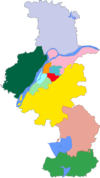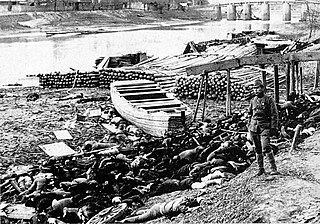
The Nanjing Massacre or the Rape of Nanjing was the mass murder and mass rape of Chinese civilians in Nanjing, the capital of the Republic of China, immediately after the Battle of Nanking in the Second Sino-Japanese War, by the Imperial Japanese Army. Beginning on December 13, 1937, the massacre lasted six weeks. The perpetrators also committed other war crimes such as looting, torture, arson, and beheadings. The massacre is considered by historians to be one of the worst wartime atrocities committed in human history.

The Battle of Nanking was fought in early December 1937 during the Second Sino-Japanese War between the Chinese National Revolutionary Army and the Imperial Japanese Army for control of Nanjing (Nanking), the capital of the Republic of China.
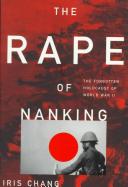
The Rape of Nanking: The Forgotten Holocaust of World War II is a bestselling 1997 non-fiction book written by Iris Chang about the 1937–1938 Nanjing Massacre — the mass murder and mass rape of Chinese civilians committed by the Imperial Japanese Army in Nanjing, the capital of the Republic of China, immediately after the Battle of Nanjing during the Second Sino-Japanese War. It describes the events leading up to the Nanjing Massacre, provides a graphic detail of the war crimes and atrocities committed by Japanese troops, and lambastes the Japanese government for its refusal to rectify the atrocities. It also criticizes the Japanese people for their ignorance about the massacre. It is one of the first major English-language books to introduce the Nanjing Massacre to Western and Eastern readers alike, and has been translated into several languages. The book significantly renewed public interest in Japanese wartime conduct in China, Korea, Southeast Asia and the Pacific.

Iris Shun-Ru Chang was an American journalist, author of historical books and political activist. She is best known for her best-selling 1997 account of the Nanjing Massacre, The Rape of Nanking, and in 2003, The Chinese in America: A Narrative History. Chang is the subject of the 2007 biography Finding Iris Chang, and the 2007 documentary film Iris Chang: The Rape of Nanking starring Olivia Cheng as Iris Chang. The independent 2007 documentary film Nanking was based on her work and dedicated to her memory.
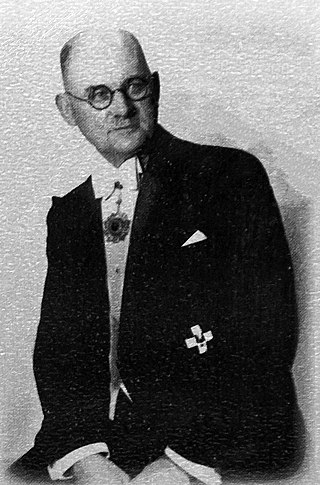
John Heinrich Detlef Rabe was a German businessman and Nazi Party member best known for his efforts to stop war crimes during the Japanese Nanjing Massacre and his work to protect and help Chinese civilians during the massacre that ensued. The Nanking Safety Zone, which he helped to establish, sheltered approximately 250,000 Chinese people from being killed. He officially represented Germany and acted as senior chief of the European-U.S. establishment that remained in Nanjing, the Chinese capital at the time, when the city fell to the Japanese troops.

Wilhelmina "Minnie" Vautrin was an American missionary, diarist, educator and president of Ginling College. A Christian missionary in China for 28 years, she became known for caring and protecting at least 10,000 Chinese refugees during the Nanjing Massacre in China, during which she kept a now-published diary, at times even challenging the Japanese authorities for documents in an attempt to protect the civilians staying at her college.
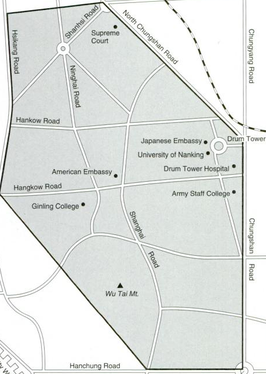
The Nanking Safety Zone was a demilitarized zone for Chinese civilians set up on the eve of the Japanese breakthrough in the Battle of Nanking. Following the example of Jesuit Father Robert Jacquinot de Besange in Shanghai, the foreigners in Nanjing created the Nanking Safety Zone, managed by the International Committee for the Nanjing Safety Zone led by German businessman and Nazi party member John Rabe. The zone and the activities of the International Committee were responsible for safely harboring 250,000 Chinese civilians from death and violence during the Nanjing Massacre.
John Gillespie Magee was an American Episcopal priest, best known for his work in Nanjing as a missionary, and for the films and pictures he shot during the Nanjing Massacre. He is also credited with saving thousands of lives throughout the event.
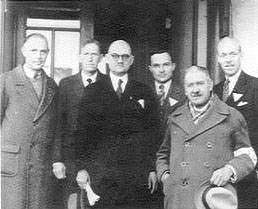
The International Committee was established in 1937 to establish and manage the Nanking Safety Zone.

Nanking is a 2007 documentary film about the Nanjing Massacre, committed in 1937 by the Japanese army in the former capital city Nanjing, China. It was inspired by Iris Chang's book The Rape of Nanking (1997), which discussed the persecution and murder of the Chinese by the Imperial Japanese Army in the then-capital of Nanjing at the outset of the Second Sino-Japanese War (1937–45). The film draws on letters and diaries from the era as well as archive footage and interviews with surviving victims and perpetrators of the massacre. Contemporary actors play the roles of the Western missionaries, professors, and businessmen who formed the Nanking Safety Zone to protect the city's civilians from Japanese forces. Particular attention is paid to Nazi Party member John Rabe, a German businessman who organized the Nanking Safety Zone, Robert O. Wilson, a surgeon who remained in Nanjing to care for legions of victims, and Minnie Vautrin, a missionary educator who rendered aid to thousands of Nanjing's women.

The Good Man of Nanking: The Diaries of John Rabe is a collection of the personal journals of John Rabe, a German businessman who lived in Nanjing at the time of the Nanjing Massacre in 1937–1938. The book contains the diaries that Rabe kept during the Nanjing Massacre, writing from his personal experience and observation of the events that took place. It also excerpts Rabe's experience in immediate post-war Berlin, then occupied by Soviet troops. Rabe's diaries were made known and quoted by author Iris Chang during the research for her book, The Rape of Nanking; they were subsequently translated from German to English by John E. Woods and published in the United States in 1998. The diaries of Rabe could only provide witnesses of a small corner of the Nanjing Massacre, because of the limitation of his activity in the safe zone.
Robert O. Wilson, MD was an American physician born to Protestant missionaries Wilbur F. Wilson and Mary Rowley Wilson in Nanjing, China. Wilson attended Princeton University and subsequently obtained his medical training at Harvard Medical School, graduating in 1929. He returned to Nanjing in 1936, where he assumed a housestaff position at Drum Tower Hospital of University of Nanking. Amidst the chaos and bloodshed that followed in the months leading up to the Japanese occupation of Nanjing, Wilson worked tirelessly at his post, eventually becoming one among only a handful of physicians who had not left the city by 1937.
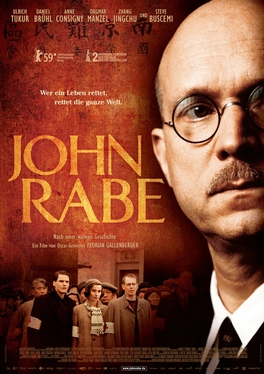
John Rabe is a 2009 biographical film directed by Florian Gallenberger, based upon John Rabe's published wartime diaries.

The Nanjing War Crimes Tribunal was established in 1946 by the government of Chiang Kai-shek to judge Imperial Japanese Army officers accused of crimes committed during the Second Sino-Japanese War. It was one of ten tribunals established by the Nationalist government.
Don't Cry, Nanking, also known as Nanjing 1937, is a 1995 Chinese film about the 1937 Nanjing Massacre committed by the Imperial Japanese Army in the former capital city Nanjing, China.

The John Rabe House (拉贝故居), located at Xiaofenqiao No. 1 (小粉桥1号) in Nanjing, China, was where John Rabe stayed during the Nanjing Massacre and protected more than 600 Chinese refugees in this house, and within its garden, from Japanese persecution. Today it accommodates the “John Rabe and International Safety Zone Memorial Hall” and the “John Rabe Research and Exchange Centre for Peace and Reconciliation.”
Nanjing Massacre denial is the pseudohistorical claim denying that Imperial Japanese forces murdered hundreds of thousands of Chinese soldiers and civilians in the city of Nanjing during the Second Sino-Japanese War. This is relevant today in Sino-Japanese relations. Most historians accept the findings of the Tokyo tribunal with respect to the scope and nature of the atrocities which were committed by the Imperial Japanese Army after the Battle of Nanjing. In Japan, however, there has been a debate over the extent and nature of the massacre with some historians attempting to downplay or outright deny that the massacre took place.
Hisashi Inoue is a Japanese historian. His area of expertise is modern Chinese history and Sino-Japanese relations. Since 2001 he has been a professor in the faculty of law at Surugadai University after having served as associate professor at the same university.
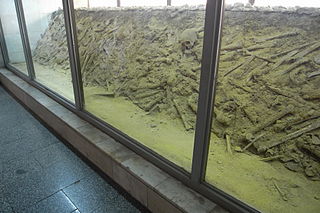
The total death toll of the Nanjing Massacre is a highly contentious subject in Chinese and Japanese historiography. Following the outbreak of the Second Sino-Japanese War, the Japanese Imperial Army marched from Shanghai to the Chinese capital city of Nanjing (Nanking), and though a large number of Chinese POWs and civilians were slaughtered by the Japanese following their entrance into Nanjing on December 13, 1937, the precise number remains unknown. Since the late-1960s when the first academic works on the Nanjing Massacre were produced, estimating the approximate death toll of the massacre has been a major topic of scholarly debate.

The National Memorial Day for the Victims of the Nanjing Massacre is a national memorial day observed in China on 13 December annually in honor of the Chinese victims of the Second Sino-Japanese War. The observance draws attention to Japanese war crimes during this period. It was established in 2014 by the Standing Committee of the 12th National People's Congress.






























